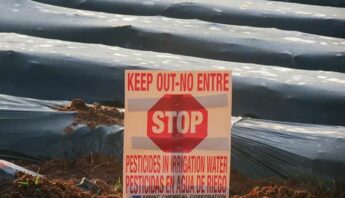I live in Santa Cruz, one of the capitals of the sustainable farming movement. It houses an organic-certifying agency, scores of non-profits that support sustainable agriculture, acres of organic production and one of the nation’s foremost organic research centers at the University of California, Santa Cruz.
Yet, just 20 miles south and within the same county, the place where I teach nutrition is very different. In fact, the Watsonville school system in the Pajaro Valley has become the battleground of a high-stakes faceoff between pesticide users, concerned teachers and parents, and public officials.
In 2014, the California Department of Public Health released a report showing that Pajaro Valley schoolchildren face the highest statewide rates of exposure to pesticides. Many schools are located next to strawberry fields, where a cocktail of drift-prone, hazardous pesticides are routinely applied.
That’s why my fellow teachers and I, in collaboration with Californians for Pesticide Reform and Pesticide Action Network, are pushing for a one-mile buffer zone of no pesticide use around California schools. There just has to be more distance between health-harming pesticides and the places where kids learn, play and grow.
Neighboring carcinogens
We know that the pesticides being used in nearby fields are affecting our children. Take, for example, the known carcinogen Telone. In 2012, Telone was found at levels exceeding cancer risk at one Watsonville elementary school. Additionally, lung-damaging chloropicrin was found at levels four times above what public agencies consider safe at a teacher’s home in Watsonville. The house in question is farther away from fields than many Pajaro Valley schools. We know this exposure adds up — as more information links pesticides to the increasing number of cancer and other diseases and disorders in the U.S.
Pesticide exposure, one of many problems
The problem of pesticide drift in California is a clear example of environmental injustice. While white-majority schools in Santa Cruz are dotted with organic gardens, Latino-majority schools in the Pajaro Valley border fields where hazardous pesticides are routinely applied. And the issue is statewide. For example, according to data from the Department of Public Health, Latino children in Monterey County are 320 percent more likely than their white peers to attend a school near pesticide applications.
Exposure to pesticides can also compound other issues kids are dealing with in their lives. The median income of Watsonville is almost half of what it is statewide, and many Watsonville children are facing the adversities of poverty — including food and housing insecurity, or lack of access to medical care. On top of that, they may face developmental delays, disabilities or cancer as a result of frequent exposure to pesticides because current state policy is insufficient.
All of this is happening to the young, developing minds and bodies of our schoolchildren. There is a saying in education that children are like sponges — they literally soak up what’s in their environment. And, unfortunately, what we’re exposing students to in Watsonville — along with over a half million other schoolchildren in the state — is hazardous pesticides.
This is unacceptable.
Pushing back, pushing forward
As teachers and community members, we’re not taking this sitting down. We are pushing for a one-mile buffer zone around schools and we are pushing hard. This February, the Department of Pesticide Regulation will be proposing new regulations about pesticide use near schools. We’ll continue to make sure the agency hears from us and we hope you’ll join our effort. To find out more, and get engaged, visit panna.org/healthy-schools.
As communities like Santa Cruz show, vibrant sustainable agriculture doesn’t have to rely on heavy pesticide use. State officials should encourage growers to use land near schools as innovation zones, places to practice pesticide-free farming and test new methods. These simple changes — one-mile buffers and agriculture innovations zones — can have huge impacts on this generation of California schoolchildren and those to come.







